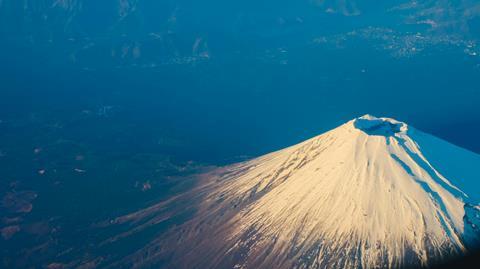
JAPAN: An interim report by Yamanashi Prefecture into a proposal to build a light rail line serving Mount Fuji has raised a series of questions about the infrastructure and rolling stock needed for a railway with gradients likely to be as steep as 8∙8%.
Published in late October, the report suggests that the alignment of the railway would follow the Fuji Subaru Line, a toll road running up the northern slopes of the mountain from Lake Kawaguchi to the fifth stage of the climb at a height of 2 305 m; the summit stands at a height of 3 776 m.
The proposed route would be double track with four intermediate stations. Two-car trains each able to accommodate 120 passengers would run at 6 min headways, taking 52 min for the ascent and 74 min for the descent. Services would operate for 10 hours a day using a fleet of 24 light rail vehicles, three of which would be held as reserves.
The report proposes that the prefecture would own the light rail infrastructure and that rolling stock and related ancillary equipment would be owned by a private concern. The capital investment cost for the project is cited as ¥148∙6bn and, assuming ridership of around 3 million passengers a year, operations could achieve profitability within 40 years. The report suggests that the railway would generate ¥1∙56tr in the local economy over that period and create direct or indirect jobs for over 120 000 people.
Among the issues facing planners is the proposal for the tracks to follow the alignment of the toll road, which would be shared by light rail and road vehicles. The road has gradients varying from 5∙2% to 8∙8% with numerous curves, some having a radius of just 27∙5 m. Added to that is the complex underlying geology of the mountain, which consists of volcanic basalt, and a temperature range varying from -20°C in winter to around 20°C in the summer.
The proposals envisage catenary-free operation because of heavy snowfall, high winds and visual impact. Low-floor accessible vehicles would need to be powerful enough to climb the steep grades with a full passenger load in low temperatures.
Manufacturers have responded by raising a number of concerns. These include development and testing of a vehicle powerful enough to be able to climb the steep gradients, possibly towing another vehicle in the event of a breakdown. As some of the steepest grades occur on the sharpest bends, the high rolling resistance could increase the risk of derailment.
Descending trains would have to use regenerative braking along the full 24∙1 km length of the line, and measures would be needed to deal with a possible failure of regenerative braking equipment. Catenary-free operation would require the use of battery-powered or fuel-cell vehicles or a form of ground-based current collection with a third rail; the report suggested that a combination of battery and third rail operation could be feasible.
Manufacturers also pointed to the difficulty of accommodating traction and braking equipment without compromising a low-floor design. Whereas it would normally take four years to design and build a new vehicle type, the suppliers concluded that it would take at least 10 years to develop and test a suitable vehicle. Development costs could range from ¥1bn to ¥4bn.

















